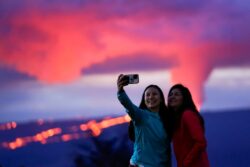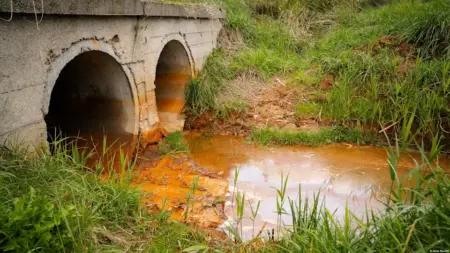Ingrid Yang, left, and Kelly Bruno, both of San Diego, take a photo in front of lava erupting from Hawaii’s Mauna Loa volcano (Picture: AP)
Thousands of awestruck disaster tourists flocked to watch the world’s largest volcano spew rivers of glowing lava – jamming a highway that could soon be engulfed by the molten flow.
Mauna Loa awoke from its 38-year slumber on Sunday, sending plumes of volcanic ash billowing into the sky and debris falling onto the ground.
A main highway linking towns on the east and west coasts of Hawaii’s Big Island became an impromptu viewing point, with thousands of cars jamming the road near Volcanoes National Park.
Anne Andersen left her overnight shift as a nurse to see the spectacle on Wednesday, afraid that the road would soon be closed.
Watching the volcano smoulder on the horizon, she said: ‘It’s Mother Nature showing us her face. It’s pretty exciting.’
Gordon Brown, a visitor from Loomis, California, could see the bright orange lava from the bedroom of his rental house. So he headed out for a close-up view with his wife.
‘We just wanted — to come see this as close as we could get. And it is so bright, it just blows my mind,’ Brown said.
Lava flows down the mountain (Picture: AP)
Spectators watch on (Picture: AP)
Brian Lichtenstein, of San Diego, takes a photo (Picture: AP)
Mauna Loa last erupted in 1984 (Picture: Anadolu Agency via Getty Images)
A main highway linking towns on the east and west coasts of Hawaii’s Big Island became an impromptu viewing point (Picture: AP)
The lava was tumbling slowly down the slope and was about six miles from the highway known as Saddle Road. It was not clear when, or if, it would cover the road, which runs through old lava flows.
The road bisects the island and connects the cities of Hilo and Kailua-Kona.
People traveling between them would need to take a longer coastal road if Saddle Road becomes impassable, adding several hours of drive time.
Ken Hon, scientist in charge at the Hawaiian Volcano Observatory, said at current rate of flow, the soonest the lava would get to the road is two days, but he added that things could change.
The world’s biggest active volcano erupted for the first time in almost 40 years (Picture: Getty)
Lava flows moving northeast downslope of Mauna Loa volcano (Picture: Reuters)
Mauna Loa last erupted in 1984. The current eruption is its 34th since written record keeping began in 1843.
Its smaller neighbour, Kilauea, has been erupting since September 2021, so visitors to the national park were being treated to the rare sight of two simultaneous eruptive events: the glow from Kilauea’s lava lake and lava from a Mauna Loa fissure.
Abel Brown, a visitor from Las Vegas, was impressed by the natural forces on display. He planned to take a close-up helicopter tour later in the day — but not too close.
‘There’s a lot of fear and trepidation if you get really close to it,’ Brown said. ‘The closer you get, the more powerful it is and the more scary it is.’
Officials were initially concerned that lava flowing down Mauna Loa would head toward the community of South Kona, but scientists later assured the public the eruption had migrated to a rift zone on the volcano’s northeast flank and wasn’t threatening communities.
It started erupting on Sunday (Picture: MediaPunch/Shutterstock)
It turned the night sky a reddish orange (Picture: AP)
The smell of volcanic gases and sulphur was thick along Saddle Road, where people watched the wide stream of lava creep closer.
Clouds cleared to reveal a large plume of gas and ash rising from a vent on the mountain.
Governor David Ige issued an emergency proclamation to allow responders to arrive quickly or limit access as needed.
Lava crossed the Mauna Loa Observatory access road Monday night and cut off power to the facility, Hon said.
It could move toward the county seat of Hilo, he added, but that could take a week or longer.
Meanwhile, scientists are trying to measure the gas emitted from the eruption.
‘It’s just very early in this eruption right now,’ Hon said.
Get in touch with our news team by emailing us at [email protected].
For more stories like this, check our news page.
‘It’s Mother Nature showing us her face. It’s pretty exciting.’





